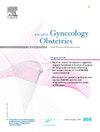使用孕激素刺激卵巢方案或促性腺激素释放激素拮抗剂方案进行植入前非整倍体基因检测后的非整倍体率和临床妊娠结果。
IF 1.6
4区 医学
Q3 OBSTETRICS & GYNECOLOGY
Journal of gynecology obstetrics and human reproduction
Pub Date : 2024-11-19
DOI:10.1016/j.jogoh.2024.102883
引用次数: 0
摘要
目的研究采用孕激素刺激卵巢(PPOS)方案或促性腺激素释放激素(GnRH)拮抗剂方案进行非整倍体植入前基因检测(PGT-A)后的染色体异常率和临床妊娠结局:研究纳入了2018年1月至2021年12月期间使用PPOS方案(n = 320个周期)或GnRH拮抗剂方案(n = 111个周期)进行控制性卵巢刺激的431个PGT-A周期。随后,在309个周期中进行了冷冻胚胎移植,移植了可移植囊胚。比较了两种方案的取卵数量、胚胎发育、新一代测序结果和临床妊娠结局。主要结果指标是非整倍体率。次要结果指标是每个首次冻融胚胎移植周期的临床妊娠率和每个 PGT-A 周期的累积活产率:结果:在取回的卵母细胞数、可用囊胚数和优质囊胚率方面,组间差异无统计学意义。两组的非整倍体率相似。冷冻解冻胚胎移植周期后的临床妊娠结局,包括临床妊娠率、着床率、流产率、活产率和累积活产率均无明显差异(P>0.05):研究发现,使用 PPOS 方案和使用 GnRH 拮抗剂方案的患者在 PGT-A 周期后的非整倍体率、临床妊娠率和累积活产率方面均无明显差异。本文章由计算机程序翻译,如有差异,请以英文原文为准。
Aneuploidy rates and clinical pregnancy outcomes after preimplantation genetic testing for aneuploidy using the progestin-primed ovarian stimulation protocol or the gonadotropin-releasing hormone antagonist protocol
Objective
To investigate the chromosome abnormality rates and clinical pregnancy outcomes after preimplantation genetic testing for aneuploidy (PGT-A) using either the progestin-primed ovarian stimulation (PPOS) protocol or the gonadotropin-releasing hormone (GnRH) antagonist protocol.
Methods
The study included 431 PGT-A cycles in which controlled ovarian stimulation was performed using the PPOS protocol (n = 320 cycles) or GnRH antagonist protocol (n = 111 cycles) between January 2018 and December 2021. Frozen embryo transfer was subsequently performed in 307 cycles with transferable blastocysts. The number of retrieved oocytes, embryo development, next-generation sequencing results, and clinical pregnancy outcomes were compared between the two protocols. The primary outcome measure was the aneuploidy rate. Secondary outcome measures were clinical pregnancy per first frozen-thawed embryo transfer cycle and cumulative live birth rates per PGT-A cycle.
Results
There were no statistically significant between-group differences in the number of retrieved oocytes, available blastocysts, and high-quality blastocyst rate. The aneuploidy rates were similar between the two groups. There was no significant difference in clinical pregnancy outcomes, including the clinical pregnancy, implantation, miscarriage, live birth, or cumulative live birth rates, after frozen-thawed embryo transfer cycles (P>0.05).
Conclusions
The study found no significant differences in the aneuploidy rate, clinical pregnancy rate and cumulative live birth rate after PGT-A cycles between those using the PPOS protocol and those using the GnRH antagonist protocol.
求助全文
通过发布文献求助,成功后即可免费获取论文全文。
去求助
来源期刊

Journal of gynecology obstetrics and human reproduction
Medicine-Obstetrics and Gynecology
CiteScore
3.70
自引率
5.30%
发文量
210
审稿时长
31 days
期刊介绍:
Formerly known as Journal de Gynécologie Obstétrique et Biologie de la Reproduction, Journal of Gynecology Obstetrics and Human Reproduction is the official Academic publication of the French College of Obstetricians and Gynecologists (Collège National des Gynécologues et Obstétriciens Français / CNGOF).
J Gynecol Obstet Hum Reprod publishes monthly, in English, research papers and techniques in the fields of Gynecology, Obstetrics, Neonatology and Human Reproduction: (guest) editorials, original articles, reviews, updates, technical notes, case reports, letters to the editor and guidelines.
Original works include clinical or laboratory investigations and clinical or equipment reports. Reviews include narrative reviews, systematic reviews and meta-analyses.
 求助内容:
求助内容: 应助结果提醒方式:
应助结果提醒方式:


